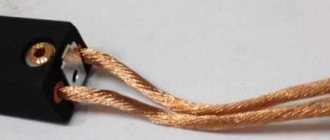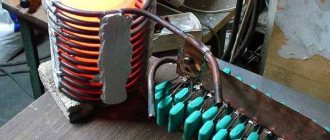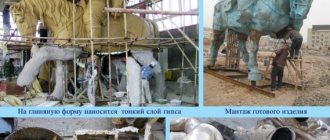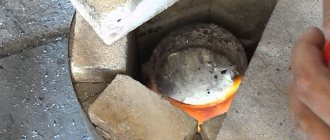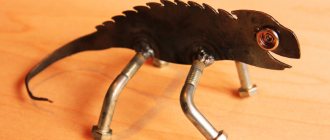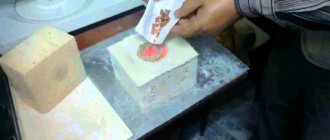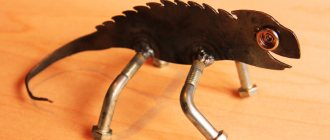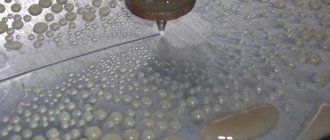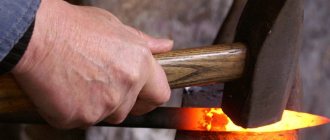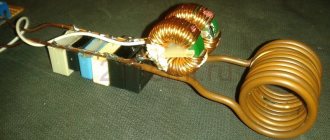–Categories
- Ceramic kilns (2)
- Ceramic crucibles and mortars (8)
- Abrasive stones and files (2)
- Ceramic tumbling filler (3)
- Our production (6)
–Search by diary
–Subscription by e-mail
-Statistics
Saturday, February 18, 2022 23:52 + in quote book
Many craftsmen make crucibles for melting metals with their own hands, they have developed their technologies, and the quality of such products is quite good. If making a crucible with your own hands is a new thing for you, then this review will help you decide which path to take next: make the crucible yourself or buy it from a direct manufacturer without intermediaries.
Let's start with the fact that the materials for making a crucible with your own hands can be pieces of stainless steel pipes, cast iron, clay, fireclay chips, charcoal, graphite, etc. It would seem that the materials are cheap, the cost of a homemade crucible should also be low. However, in practice, when making a high-quality and cheap crucible at home, craftsmen are faced with a number of problems. In this review we will not dwell on graphite crucibles and their burnout problems when melting metals. Here we will dwell in more detail on the problems of making ceramic crucibles with our own hands. I will describe the most common of them:
- The main problem is the heterogeneous composition of the clay masses. Different clay deposits are characterized by different compositions, and in order to obtain high-quality ceramic products, clays of a certain qualitative and quantitative composition are required.
- Clays used to make ceramic crucibles shrink; different clays shrink differently. If you prepare crucibles in large batches and purchase one type of clay in large quantities, then this is not a problem. The shrinkage of the clay is calculated in advance, and the finished product is obtained in a given shape and the variation in overall dimensions is extremely small. But if ceramic crucibles are made from case to case, different batches of clay are used, then maintaining the required dimensions turns out to be problematic, and the percentage of defects increases.
- Homemade ceramic crucibles can withstand a small amount of melting; when using sodium tetraborate (borax), homemade ceramic crucibles quickly become covered with microcracks and become unsuitable for further melting of metal.
- Homemade crucibles are often not sufficiently dried, which is why, when the metal melts, additional stress appears in the body of the crucible and the crucible bursts.
- Homemade ceramic crucibles are thick-walled and require more heating time; energy consumption increases when melting metal.
The best option for melting most metals is a ceramic crucible, but not every ceramic crucible is suitable for melting metal. Let's consider this issue in more detail. Let's start with the fact that ceramic crucibles, which are most often found on the Russian market, are divided into porcelain, corundum and quartz ceramic crucibles. Porcelain crucibles are not suitable for melting many metals due to their relatively low fire resistance. Corundum crucibles are fire-resistant and durable, but when melting metal there is one very important limitation: the corundum crucible cannot be sharply heated and cooled, the cooling rate of the corundum crucible is 2-3 ° C/minute. For melting metal in a temperature changing mode, a crucible made of sintered quartz ceramics is suitable.
A crucible made of quartz ceramics is inert towards metals, fireproof, chemically resistant, and can withstand sudden temperature changes. For an inexperienced person, making a high-quality crucible from sintered quartz ceramics will require unreasonably large amounts of time, material and energy for experimental work. Thus, for a beginner it is much more profitable not to make a crucible for melting metals with your own hands, but to buy it directly from the crucible manufacturer. Prices for quartz ceramic crucibles can be found here (price list).
Author: Kolesnikov Yuri Fedorovich, heating engineer*
© When using site materials (quotes, images), the source must be indicated.
Crucible is a vessel for melting metal. As a rule, conversion metal is melted in crucibles, i.e. already brought to the required degree of quality for casting into a mold or refining (deep purification from impurities). The general line of development of large-scale metallurgy is to reduce the number of processing steps, up to the release of conditioned metal directly from the melting furnace, but in industry crucible melting still retains significant importance, and in handicrafts and jewelry it dominates.
The crucible is not just a fairly heat-resistant vessel. Its chemical composition and design must correspond to the type of metal being melted and the melting mode. This article describes how to make a crucible with your own hands and what conditions it must satisfy for use at home or in a small workshop. For beginner metallurgists, you will first have to touch on the metal smelting process itself, because... The requirements for the crucible are determined mainly by its conditions.
Melting metal in a crucible at home
DIY crucible
To melt metals, special heat-resistant bowls called crucibles are used. They are very popular in jewelry workshops, laboratories and the metallurgical industry. But for a full-fledged process, it is not enough to acquire a simple object with a heat-resistant surface, because different iron requires its own product, which must correspond to the chemical composition and be suitable for a specific temperature regime. These facilities also produce a finished alloy, which remains to be given the correct shape.
Sometimes it happens that such devices may be needed in private business, but purchasing them is expensive. Therefore, it is more profitable to make a crucible with your own hands - you can save a significant share of the budget. Yes, the procedure will require certain skills and patience, but in the end you will get a vessel that is not inferior to factory analogues. It is also important to decide on the types of objects to be melted in order to make a suitable bowl. If you plan to work with different metals, it is recommended to create several products.
Types of induction furnaces
In the group of metallurgical production equipment, several types of furnaces can be distinguished:
- Crucible.
One of the most common types in metallurgy.
There is no core in the design of such units. Such devices can be used for melting and processing any metals. They have proven themselves well not only in metallurgy, but also in other industries, for example, in jewelry.
The most important elements of an induction crucible furnace are:
- inductor;
power supply generator.
Advantages of crucible melting furnaces:
- Energy release directly into the load, without intermediate heating elements;
- Intense electrodynamic circulation of the melt in the crucible, ensuring rapid melting of small batches and waste, equalization of temperature throughout the volume of the bath and the absence of local overheating, guaranteeing the production of multicomponent alloys that are homogeneous in chemical composition;
- The fundamental possibility of creating any atmosphere (oxidizing, reducing or neutral) in the furnace at any pressure;
- High performance achieved thanks to high power densities, especially at mid frequencies;
- The possibility of completely draining the metal from the crucible and the relatively small mass of the furnace lining, which creates conditions for reducing the thermal inertia of the furnace due to a decrease in the heat accumulated by the lining. Furnaces of this type are convenient for periodic operation with breaks between melts and provide the ability to quickly switch from one grade of alloy to another;
- Simplicity and ease of furnace maintenance, control and adjustment of the smelting process, ample opportunities for mechanization and automation of the process;
Duct.
The design resembles a transformer.
Vacuum.
They are used when it is necessary to ensure the removal of impurities from the melt.
The design of an induction heater is a multi-turn cylindrical coil, which is called an inductor; an alternating current electric voltage is passed through it, resulting in magnetic fields that excite eddy currents.
A vessel or container containing metal or ore is placed in the internal space of the inductor. Under the influence of a magnetic field and eddy currents, the resistance in the metal increases, which, according to all the laws of physics, causes it to heat up and, due to this, the melting process occurs.
The power of induction melting furnaces depends on the magnitude of the applied voltage and the frequency of the electric current. This relationship is used in the types of induction furnaces - heat treatment heating units and melting furnaces.
Industrial furnaces are divided into several types.
- Medium frequency designs are commonly used in mechanical engineering and metallurgy. With their help, steel is melted, and when using graphite crucibles, non-ferrous metals are melted.
- Industrial frequency designs are used in iron smelting.
- Resistance structures are intended for melting aluminum, aluminum alloys, and zinc.
The induction furnace is widely used in large and small enterprises for melting metals (non-ferrous and ferrous). In induction casting furnaces, a metal or alloy is heated until its state of aggregation changes.
At the same time, channel furnaces, despite their higher efficiency, are used much less frequently - mainly for the production of high-quality cast iron and alloys, the melting point of which is relatively low, as well as for the melting of non-ferrous metals.
Such furnaces are not used for steel, since its melting temperature greatly reduces the durability of the lining (protective finish). Also, you cannot melt low-grade rock, shavings and small rock.
Crucible furnaces are used much more often due to their ease of operation and greater process control capabilities, including the possibility of irregular and intermittent operation. They are good both for the production of large quantities of castings of several tens of tons, and for small portions measured in tens of grams.
Crucible furnaces are used to melt alloy steels and other alloys that require special purity of the chemical composition and homogeneity.
Material selection
Here, fire-resistant components play a serious role, which include:
- Ceramics is an average option, perfect for personal use. There are no reactions that can change the structure of the metal in this cookware, and it is excellent for cobalt, chromium and palladium.
- Clay is a substance that is used in the production of crucibles for jewelers. This component is highly fire-resistant and can withstand up to +1600 °C. If a person wants to create jewelry in his own room, but does not know what to use for melting, then this option is definitely the best.
- Graphite is excellent for melting galvanized and brass alloys, and its main advantage is durability. As for the operating temperature, it should not exceed +800 °C.
- Cast iron. Crucibles made from this substance are rare and belong to the budget categories. Also, products of this kind will have disadvantages in the form of rapid oxidation, low heat resistance and fast production (up to 30 heats).
Varieties of homemade crucibles
As an alternative, you can use an electric crucible, which you can do yourself without much difficulty. It has several uses, but the main one is gold refining.
Types of crucibles
Crucibles mainly differ in the material used in their manufacture. Billet raw materials can be divided into two types – metals and non-metals. If we talk about the first group, then cast iron will be the most popular basis for construction. It is good primarily for its resistance to temperature influences and the possibility of safe contact with other metal alloys. However, these advantages only apply when comparing cast iron containers with other metal counterparts. On the contrary, if you compare cast iron crucibles with non-metallic molds, you will find disadvantages in the form of high reactivity and oxidation, not to mention the high cost of such a solution. Now you can turn to the second group of materials. What are crucibles made from non-metallic raw materials? These are ceramic, clay and graphite products that are characterized by resistance to thermal effects and oxidation processes. In addition, ceramics do not in any way affect the chemical composition of the alloy being served, which is also a plus. Practice shows that such crucibles can safely accept alloys of palladium, chromium or cobalt. The most popular are graphite and clay products, which are worth considering separately.
General manufacturing steps
To begin with, the raw materials are prepared, and here everything depends on the model of the future tank. It is better to take components with a reserve, because the first thing is unlikely to work out. Also, for safety reasons, you should carry out production away from open fire, and choose a well-ventilated area.
It is safer to carry out work in a garage or special extension.
The second stage is mixing the materials and giving the casting the necessary parameters. For these purposes, plaster molds are used. Creating the outlines is not difficult, and such information is easy to find on the Internet. Then a homogeneous material is pasted over the outer part of the model, forming a future homemade refractory crucible. It is also important to give it the required depth and thickness.
Clay crucible in the drying process
And the last step is the drying process: the workpiece is placed in a cardboard box and covered with a lid. This will allow the casting to dry and remove excess water from it. Sometimes heat treatment may be required, however, the important point is to control the annealing temperature and protect the skin of the hands and face. If the heat is too intense, the item will burst and there is a chance of severe burns. Detailed instructions on how to make a crucible yourself and at home will be described in the following chapters.
Casting shape
If you only need to cast pure aluminum for solder, then a casting mold is not needed. It is enough to use a steel sheet on which the molten metal will cool. But if you need to cast even a simple part, you will need a casting mold.
The casting mold can be made from sculptural plaster, namely gypsum, not alabaster. Liquid plaster is poured into an oiled mold, allowed to harden a little, shaking occasionally to release air bubbles, the model is inserted into it and covered with a second container of plaster. In a convenient place, you need to insert a cylindrical object into the plaster so that eventually a hole appears in the mold, the so-called channel, into which molten aluminum will be poured. When the plaster has completely hardened, the two parts of the mold are separated, the model is taken out, and the mold with the finished cast is connected again.
A casting mold can also be made from a mixture of 75% foundry sand, 20% clay and 5% coal sand, which is poured into a special box made of boards and compacted. The model is pressed into the compacted earth, the resulting imprint is sprinkled with talcum powder and graphite (coal dust) so that the cooled aluminum part can be easily separated from the mold.
Read also: Which hiller is best for a walk-behind tractor?
Making a clay crucible
Here you can’t do without fireclay clay, which is sold in any building materials store. It tolerates extreme thermal effects very well, is cheap and there are unlikely to be any problems finding it. As a last resort, you can make a crucible from crushed fireclay bricks. You will also have to buy liquid glass and mix all the ingredients for a homogeneous base. The proportions look something like this:
All components are added in stages: clay and fireclay are mixed until smooth, and water is gradually added to them. The main goal is to create a mixture that will not stick to your hands. When the required consistency is obtained, glass is added and everything is thoroughly mixed. The main thing here is to bring the object to a state where the plane stops cracking. The mixture is ready, and for storage it is recommended to use thick cellophane, or wrap it in 7-10 layers of film.
Before sculpting, you will have to remove any remaining air by hitting the substance about 8-12 times on a hard surface.
The mixed material is applied inside the model, its depth and thickness are formed. It is better to create a semicircular bottom, which will give a greater effect during future melting of iron filings. Also, the substance must be pressed tightly against the model so that air does not form between the planes, and for greater convenience it is recommended to wet your hands with water.
Afterwards, the tank is sent for drying: it is placed in a container made of cardboard or plastic and placed in a dry place. A few hours will be enough to remove any remaining moisture. Also, the product will settle a little, and it will be easy to remove it from the mold. A refractory vessel made of fireclay bricks will be enough for a long time of use, however, the last point of creation should be the firing procedure in a furnace and at T = 800 °C. And the thing can be used for its intended purpose. For ease of use, you will need a crucible furnace, which you can make yourself. For simple installation, you can weld a structure from several pipes to form a cylinder. Usually it is fixed on two parallel posts so that it does not touch the ground. And here the thickness of the walls (minimum 5 mm) and the stability of the product are taken into account (it must easily withstand T = 1600 °C or more).
How to make a mixture for a neutral type ceramic crucible?
First you need to prepare the form of a homemade crucible for melting lead.
This is done according to the following algorithm: Dry clay is mixed with ground fireclay until a homogeneous consistency is obtained. It is recommended to make 20 revolutions in the fireclay mill.
- As soon as the required state is achieved, you can unload the mass and begin mixing by hand, adding water little by little. The mixture, in the right condition, will form a lump and will not stick to the skin or leak through your fingers.
- Now you need to add silicate stationery glue.
- Mix the whole mass thoroughly. It is worth noting that this is the most difficult and time-consuming stage. Continue processing until a homogeneous consistency is obtained.
- The next step in creating a crucible for melting lead with your own hands will be to remove air from the finished mixture. It is necessary to ensure that not a single bubble remains in it. Otherwise, the crucible will burst when overheated. To avoid this, the air must be knocked out.
- Spread a film on the hard floor (never use newspapers!).
- Now the fun begins. To eliminate all the air from the workpiece, it is necessary to throw it onto the film with maximum force. Do this until the bubbles stop coming out of the mass. After that, throw 10 more times (more is possible).
- After the procedure for removing air from the mixture has been completed, it can be stored. To keep it for as long as possible, you should use glass containers with a hermetically sealed lid.
Attention! Do not store the workpiece in a plastic container or wrapped in several layers of film. It will dry out in a couple of weeks and will be unusable!
Assembling a cast iron crucible
This type is the worst, but sometimes it brings good benefits. All that is required is to place a cast iron glass of a smaller diameter in a metal bowl, and fill the free space with sand and clay.
DIY cast iron crucible
Next, everything is heated in the oven until the mixture melts and takes on the same type of substance. Afterwards, the cup will harden, and iron can be melted in it. This is basic information on how to make a crucible at home and at minimal cost.
Source
Making a crucible furnace
The easiest way to make a crucible is to simply weld it from a piece of pipe of the most suitable diameter. When choosing the trim itself, you need to consider several important factors.
First, the width of the walls should be at least half a centimeter. Second, your scrap must be made of a metal that melts at a higher temperature than the alloys you plan to melt. Cast iron is ideal for this. After this, the pipe must be cleaned, or all excess can be simply burned in the oven. Now your homemade crucible furnace is in no way inferior to any other.
To safely remove molten metal from the crucible, attach a small spout to it. To do this, grind the top a little with a grinder and go through it with a file. To make it, use a piece of metal cut at an angle.
You can also attach a handle to your homemade crucible furnace; use a nut and screw the handle into it, which will help you immerse and remove the crucible from the furnace more safely. All you need is a couple of turns of the handle, and your crucible will be held in a death grip, thus preventing accidental tipping or spilling of molten aluminum on yourself or people who may be nearby at that moment. All the safety measures mentioned above will come in very handy when melting non-ferrous metals at home. As you can now see, installing a crucible furnace with your own hands is a fairly simple task. I hope you will now never ask yourself again: how to make a crucible furnace?
Crucible: purpose, principles of melting, manufacturing, options, diagrams
Author: Yuriy Fedorovich Kolesnikov, thermal power engineer*
© When using site materials (quotes, images), the source must be indicated.
Crucible is a vessel for melting metal. As a rule, conversion metal is melted in crucibles, i.e. already brought to the required degree of quality for casting into a mold or refining (deep purification from impurities). The general line of development of large-scale metallurgy is to reduce the number of processing steps, up to the release of conditioned metal directly from the melting furnace, but in industry crucible melting still retains significant importance, and in handicrafts and jewelry it dominates.
The crucible is not just a fairly heat-resistant vessel. Its chemical composition and design must correspond to the type of metal being melted and the melting mode. This article describes how to make a crucible with your own hands and what conditions it must satisfy for use at home or in a small workshop. For beginner metallurgists, you will first have to touch on the metal smelting process itself, because... The requirements for the crucible are determined mainly by its conditions.
Melting metal in a crucible at home
Features of graphite crucibles
Products made of graphite and carbon demonstrate increased chemical and thermal resistance, which determines their value in metallurgy. For example, special graphite compositions can withstand temperatures of about 3000 °C. It is obvious that such a crucible can be used for melting metal in almost all areas of the metallurgical industry. The equipment is used for melting, distributing, pouring non-ferrous and ferrous metals - including in combination with induction vacuum furnaces. The manufacturing technology of graphite crucibles makes it possible to precisely calculate their shape and dimensions down to the smallest detail. Most often, the dimensions are oriented to the specific design of the induction furnace. For example, forms in the form of glasses are common, where other technological additions are also present - spouts, collars, holes, etc. But graphite raw materials are much more expensive than other materials, so the equipment is used mainly in the professional field. Although there are exceptions when home craftsmen dilute the compositions with cheaper materials.
A little about melting
In a deep vacuum, the high-purity metal being melted can be heated exactly to the melting temperature or slightly higher, and kept at it for some time so that tiny, literally a few atoms, remains of crystallites melt. Then the metal can be allowed to cool slightly below its melting point - it will remain liquid, like a supersaturated solution without a seed crystal. If we now pour the metal, also in a vacuum, into a mold made of a chemically absolutely inert material, in which a seed crystal of the same metal is placed, then, observing all the subtleties of this technology, we will obtain a single-crystal casting with unique properties.
In amateur conditions, vacuum melting, alas, is not feasible. In order to properly make a crucible for melting metal yourself, you need to take into account a number of features of melting in a non-inert chemical gas environment. The melted metal, firstly, interacts with air, causing part of it to be lost to the formation of oxide, which is especially important when melting scrap precious metals: at its melting temperature (1060 degrees Celsius), even gold noticeably oxidizes. To compensate to some extent for oxidation, the crucible must provide a reducing environment for the melt or be chemically inert if the metal is melted with a clean open flame, see below.
Secondly, so that the metal in the crucible does not freeze until it is brought to the casting mold, so that the remnants of the original crystallites do not spoil the casting, and the melt acquires sufficient fluidity, the metal in the crucible is overheated. For example, the melting point of zinc is 440 degrees, and its foundry temperature is 600. Aluminum, respectively, 660 and 800. Since overheating of the metal after melting takes some time, degassing of the melt also occurs at the same time, this is the third thing.
Recovery
In metallurgy, atomic carbon C, carbon monoxide CO (carbon monoxide) and hydrogen H are used as reducing agents. The latter is most often an accidental guest, because for this purpose it is too active and is absorbed by metals without forming chemical compounds with them in large quantities, which spoils the casting material. For example, solid platinum at room temperature can absorb up to 800 volumes of hydrogen. A platinum blank in a hydrogen atmosphere literally swells before our eyes, cracks and falls into pieces. If you take them out of the hydrogen chamber and heat them, hydrogen will be released back.
Note: in a similar way, but in smaller quantities, metals absorb/emit other gases, e.g. nitrogen. This is why degassing of the melt is required, see also below.
A noticeable proportion of hydrogen reduction occurs when heated by an open flame of a gas burner, upon its contact with a less heated surface. The metal does not deteriorate - the absorbed hydrogen is released and burned later in the smelting process. But, if the crucible material is also prone to gas absorption, it may crack and burst during melting; this must be kept in mind.
CO reduction is noticeable if the metal in the crucible is melted by the open flame of a liquid (gasoline, kerosene, diesel) burner, for the same reasons. Liquid fuel burns much slower than gas, and its afterburning zone extends several cm from the burner nozzle. Reduction with carbon monoxide is the cleanest from the point of view of the metal: it does not spoil the metal and does not produce by-products with a strong excess of the reducing agent. Therefore, CO reduction is widely used in metallurgy when smelting metal from ore, but no one has yet figured out how to make a crucible furnace (see below), in which oxidation compensation would be completely provided by CO.
LiveInternetLiveInternet
Many craftsmen make crucibles for melting metals with their own hands, they have perfected their technologies, and the quality of such products is quite good. If making a crucible with your own hands is a new thing for you, then this review will help you decide which path to take next: make the crucible yourself or buy it from a direct manufacturer without intermediaries.
Let's start with the fact that the materials for making a crucible with your own hands can be pieces of stainless steel pipes, cast iron, clay, fireclay chips, charcoal, graphite, etc. It would seem that the materials are cheap, the cost of a homemade crucible should also be low. However, in practice, when making a high-quality and cheap crucible at home, craftsmen are faced with a number of problems. In this review we will not dwell on graphite crucibles and their burnout problems when melting metals. Here we will dwell in more detail on the problems of making ceramic crucibles with our own hands. I will describe the most common of them:
- The main problem is the heterogeneous composition of the clay masses. Different clay deposits are characterized by different compositions, and in order to obtain high-quality ceramic products, clays of a certain qualitative and quantitative composition are required.
- Clays used to make ceramic crucibles shrink; different clays shrink differently. If you prepare crucibles in large batches and purchase one type of clay in large quantities, then this is not a problem. The shrinkage of the clay is calculated in advance, and the finished product is obtained in a given shape and the variation in overall dimensions is extremely small. But if ceramic crucibles are made from case to case, different batches of clay are used, then maintaining the required dimensions turns out to be problematic, and the percentage of defects increases.
- Homemade ceramic crucibles can withstand a small amount of melting; when using sodium tetraborate (borax), homemade ceramic crucibles quickly become covered with microcracks and become unsuitable for further melting of metal.
- Homemade crucibles are often not sufficiently dried, which is why, when the metal melts, additional stress appears in the body of the crucible and the crucible bursts.
- Homemade ceramic crucibles are thick-walled and require more heating time; energy consumption increases when melting metal.
The best option for melting most metals is a ceramic crucible, but not every ceramic crucible is suitable for melting metal. Let's consider this issue in more detail. Let's start with the fact that ceramic crucibles, which are most often found on the Russian market, are divided into porcelain, corundum and quartz ceramic crucibles. Porcelain crucibles are not suitable for melting many metals due to their relatively low fire resistance
Corundum crucibles are fire-resistant and durable, but when melting metal there is one very important limitation: the corundum crucible cannot be sharply heated and cooled, the cooling rate of the corundum crucible is 2-3 °C/minute. For melting metal under changing temperatures, a crucible made of sintered quartz ceramics is suitable.
A crucible made of quartz ceramics is inert towards metals, fireproof, chemically resistant, and can withstand sudden temperature changes. For an inexperienced person, making a high-quality crucible from sintered quartz ceramics will require unreasonably large amounts of time, material and energy for experimental work. Thus, for a beginner it is much more profitable not to make a crucible for melting metals with your own hands, but to buy it directly from the crucible manufacturer. Prices for quartz ceramic crucibles can be found here (price list).
Part 1 - Ceramic crucibles and mortars - how to choose the right one Part 2 - Porcelain crucible: purpose, advantages and disadvantages ... Part 4 - Mortar and pestle - where to buy without extra charge and how to choose Part 5 - Production of quartz ceramics Part 6 - Crucible for melting metal – why shouldn’t you do it yourself? Part 7 - Price of crucibles made of quartz ceramics of our production (price list) Part 8 - Chinese crucibles: pros and cons. Let's understand the nuances.
What to make from
Melting crucibles are made (see figure below):
- ceramic chemically neutral;
- ceramic graphite;
- graphite;
- cast iron;
- steel.
Crucibles for melting metal from various materials
Their comparative characteristics are as follows:
- Ceramic neutral - used for melting scrap jewelry while preserving the sample, because with indirect heating (see below), the properties of the metal do not change. You can do it yourself, but it’s a little complicated (see below) and is it worth it? A 50 g gold crucible costs up to 100 rubles in a jewelry store. Without any problems, they are suitable for melting in an induction furnace (see below), because almost do not absorb the energy of the electromagnetic field (EMF). Resource – 10-30 melts.
- Ceramic graphite – suitable for melting any metal; at home up to 1.5-2 kg at a time. To use an induction furnace, its power for the same amount of metal will have to be increased by 1.5-2 times due to the absorption of EMF by conductive graphite. You can do it yourself, see below. Resource – up to 50 or more melts.
- Graphite - suitable for melting old, oxidized scrap non-ferrous and precious metals, because create a strong restorative environment. Melting silver with an open gas flame in a graphite crucible makes it possible to almost completely restore the original weight of the oxidized metal. You can’t do it yourself, see below. Resource – more than 100 melts.
- Cast iron - used mainly for melting red copper into oxygen-free copper, because actively absorb oxygen. The resource is up to 30 melts, and then the amorphous carbon leaves the cast iron and the crucible degrades.
- Steel - a homemade cheap option for melting small quantities of aluminum and magnesium alloys and other chemically inert metals in the melt. Can be used for melting small amounts of lead into fishing weights, etc.
Note: graphite, cast iron and steel crucibles for use in induction furnaces (see below) are completely unsuitable, because completely absorb EMF energy.
About graphite crucibles
Graphite crucibles are made either turned from massive natural graphite (expensive), or sintered at high temperatures from graphite powder (cheaper, but still not very cheap). Hobbyists often try to make “graphite” crucibles from ground graphite with a kaolin binder, etc., but what they end up with is not graphite, but overly graphitized ceramic crucibles - fragile, withstanding no more than 10 melts and spoiling the metal due to excessive release of atomic carbon by finely dispersed graphite . A more or less rational way to use ground graphite in amateur crucible melting is to make a tabletop mini crucible furnace from it for ceramic neutral crucibles, see fig.
Graphite Mini Furnace for Jewelry Crucible Heating
Why use graphite?
- The crucible furnace can use containers made of pure graphite or a mixture of graphite powder with other binding materials. The former are more resistant to fire and stronger, having the ability to surround the metal melt with a reducing atmosphere. Crucibles made of graphite powder and additional components are endowed with less wear resistance and become dirty more quickly.
- Almost any metals and alloys can be melted in graphite crucibles.
- They have a long service life and can withstand even temperatures up to 2500˚C, which can significantly speed up the work process. Moreover, high temperatures in a crucible furnace only increase the strength of such containers.
- Graphite crucibles can be reused many times, the main thing is to remember to clean and polish them repeatedly.
- Their electrical conductivity allows the melting of precious metals without any problems.
Heating methods
If you need to melt more than 150-200 g of metal at a time, then you will need to build a crucible furnace next to the crucible, otherwise it will be very difficult to achieve homogeneity of the melt and high quality casting. The exception is low-melting and easily recoverable lead: up to 20-30 kg of it can be melted at a time at home. A relative exception is zinc for hot galvanizing; its melt in a crucible without a furnace can be up to 2-2.5 kg, but borax must be sprinkled on top of it so that the surface of the melt is completely covered with its fluidized layer. Steel fasteners are thrown into the melt through a layer of borax.
The optimal method in all respects for heating the crucible in a furnace is with gas, pos. 1 in Fig., but a gas crucible furnace is a rather complex structure, although it can easily be made independently. The most suitable crucible for a gas furnace is a graphite ceramic crucible, because its material has fairly high thermal conductivity. If there are particularly high requirements for metal purity, it is better to use a neutral ceramic crucible. When lower for fusible metals - cast iron, as it conducts heat better and thereby saves fuel. Graphite crucibles are placed in a gas furnace only if strong reduction of old oxidized metal is required, and the danger of carburization is insignificant, for example, when melting silver extracted from the earth for refining
Methods for melting metal in a crucible
For low-melting metals, the electric crucible furnace, pos. 2; it may be the so-called ohmic (with heating by a nichrome spiral) or induction, with heating from an electromagnetic oscillation generator, see below. Only ceramic neutral or, to a limited extent, graphite crucibles are suitable for induction furnaces.
If the crucible contains more than 2-2.5 kg of metal, then according to safety rules the crucible furnace must be made tiltable (item 3), because and 1 kg of melt spilled on the floor is already a big disaster. On the contrary, it is preferable to heat metal in small jewelry crucibles without a furnace, directly with the flame of a burner, pos. 4. In this case, the crucible is held throughout the melting process with a special spring grip, pos. 5 and 6.
Note: silver and its alloys, as well as lead on sinkers, can be melted at home in quantities of up to 15-20 g, using instead of a crucible... a food-grade stainless steel spoon, see fig. on right. For safety, then it is necessary to make gaskets for the jaws of the vice with longitudinal cuts under the handle of the spoon. The flame is exclusively gas; gasoline can burn a spoon.
Electric heating
Ohmic crucible furnaces are mainly used for smelting lead or tin. For more refractory metals, they turn out to be uneconomical, but up to 20 kg of lead can be melted at a time in a home crucible electric furnace; how to make your own electric crucible for melting lead, see for example. video:
Video: electric crucible for melting lead
Melting aluminum in a crucible turns out to be more profitable by induction due to its high electrical conductivity, but this trick no longer works with copper - its temperature and latent heat of fusion are much higher. With the induction melting method, the metal is heated by Foucault eddy currents, for which the crucible with it is placed in an EMF coil of thick copper wire, powered by alternating current from an electromagnetic oscillation generator. How to make a generator with your own hands for inductively heating small amounts of metal, for example, for trinkets, is described in other materials, or, for example, see next. video guide.
Video: DIY induction heating
Induction crucible furnace for aluminum melting
With an increase in the amount of melted metal, not only does the required power of the generator increase, but its optimal frequency also decreases, this affects the so-called. surface effect (skin effect) in metal. If 100-200 g of aluminum can be melted into EMF from any homemade generator for inductive heating, then installation of 1.5-2 kg of duralumin or magnesium alloy is already a solid structure, see fig. on right. If you intend to work with aluminum, then think carefully - is it worth building something like this? Wouldn't it be easier to use a mini gas furnace for melting small quantities of aluminum alloys, see for example. video clip
Video: mini furnace for melting aluminum
Step-by-step instructions for melting copper
Copper smelting, if you prepare everything necessary for the implementation of such a technological process and approach its implementation correctly, allows you to produce copper products for both decorative and purely practical purposes even at home.
To melt copper, you will need the following tools, equipment and supplies:
- muffle furnace (preferably with adjustable heating temperature);
- a crucible in which you will melt copper (for melting copper, crucibles made of ceramics or refractory clay are used);
- tongs with which the hot crucible will be removed from the furnace;
- hook (it can be made from ordinary steel wire);
- household vacuum cleaner;
- charcoal;
- the mold into which the casting will be performed;
- gas burner and forge.
Electrical copper contains the least amount of impurities
The crushed copper is placed in a crucible. Keep in mind: the smaller the pieces of metal, the faster it will melt. After filling the crucible with copper, it is placed in a furnace, which, using a temperature regulator, must be heated to the required state. The doors of serial muffle furnaces must have a window through which you can observe the melting process.
The viewing window will allow you to control the process without opening the door again, thereby not reducing the temperature in the oven
After all the copper in the crucible has melted, it must be removed from the furnace using special tongs. There is always an oxide film on the surface of the molten copper, which must be moved to one of the walls of the crucible using a steel hook. After freeing its surface from the oxide film, the molten metal should be poured as quickly and carefully as possible into a pre-prepared mold. The details and rules for performing this procedure are well demonstrated in a video that is easy to find on the Internet.
You will have to pour the metal into molds very quickly if the heating method you chose could not provide the desired temperature
If you do not have a muffle furnace at your disposal, you can heat the crucible with copper using a gas burner, placing it vertically under the bottom of the container
In this case, it is important to ensure that the flame of the gas burner is evenly distributed over the entire area of the bottom of the crucible
If at home you need to melt low-melting alloys based on copper (brass and some brands of bronze), then you can use a regular blowtorch as a heating device, also placing it vertically under the bottom of the crucible. When melting is performed using this and the previous methods, the surface of the molten metal will actively interact with oxygen, which will lead to intense oxidation. To reduce the intensity of oxidation, molten copper can be sprinkled with crushed charcoal.
Melting copper with a blowtorch in a homemade stove
If you have a forge in your home workshop, it can also be used to melt copper, brass or bronze. In this case, a crucible with crushed metal is placed on a layer of hot charcoal. To make the heating and melting process more intense, air can be supplied to the coal combustion zone, for which a regular vacuum cleaner that works not to draw in, but to blow out is suitable. If you use a vacuum cleaner, you need to make a metal tip with a small diameter blowing hole on its hose.
The smelting process will be even more efficient in a gas furnace
When selecting a muffle furnace for performing foundry operations with copper and its alloys, you should pay attention to the temperature conditions that such a device can provide. Depending on the type of metal being melted, such a furnace must provide the following heating temperatures:
- copper – 1083°;
- various grades of bronze – 930–1140°;
- brass – 880–950°.
It is possible that you will decide to make a smelting furnace yourself after watching the video.
Ordinary copper, which does not contain any alloying additives in its chemical composition, does not have good fluidity in the molten state, therefore it is not suitable for the manufacture of casting products of complex configurations and small sizes. For these purposes, it is best to use brass, and choose an alloy whose surface color is lighter (this indicates that brass of this brand has a lower melting point).
Making crucibles
Now it's time to make your own melting crucible. From the above it is clear that it makes sense to make crucibles with your own hands:
- Steel;
- Ceramic neutral;
- Ceramic graphite.
There is nothing special to say about steel crucibles - they are just a steel vessel with a welded handle. Steel crucibles are used for melting low-melting metals; sometimes - zinc for hot galvanizing with quality up to 3+. Steel crucibles for lead, tin and zinc are only suitable for melting one specific metal, because... after 1-2 melts they themselves are covered with it from the inside.
Making a crucible furnace
The easiest way to make a crucible is to simply weld it from a piece of pipe of the most suitable diameter. When choosing the trim itself, you need to consider several important factors.
First, the width of the walls should be at least half a centimeter. Second, your scrap must be made of a metal that melts at a higher temperature than the alloys you plan to melt. Cast iron is ideal for this. After this, the pipe must be cleaned, or all excess can be simply burned in the oven. Now your homemade crucible furnace is in no way inferior to any other.
To safely remove molten metal from the crucible, attach a small spout to it. To do this, grind the top a little with a grinder and go through it with a file. To make it, use a piece of metal cut at an angle.
You can also attach a handle to your homemade crucible furnace; use a nut and screw the handle into it, which will help you immerse and remove the crucible from the furnace more safely. All you need is a couple of turns of the handle, and your crucible will be held in a death grip, thus preventing accidental tipping or spilling of molten aluminum on yourself or people who may be nearby at that moment. All the safety measures mentioned above will come in very handy when melting non-ferrous metals at home. As you can now see, installing a crucible furnace with your own hands is a fairly simple task. I hope you will now never ask yourself again: how to make a crucible furnace?
